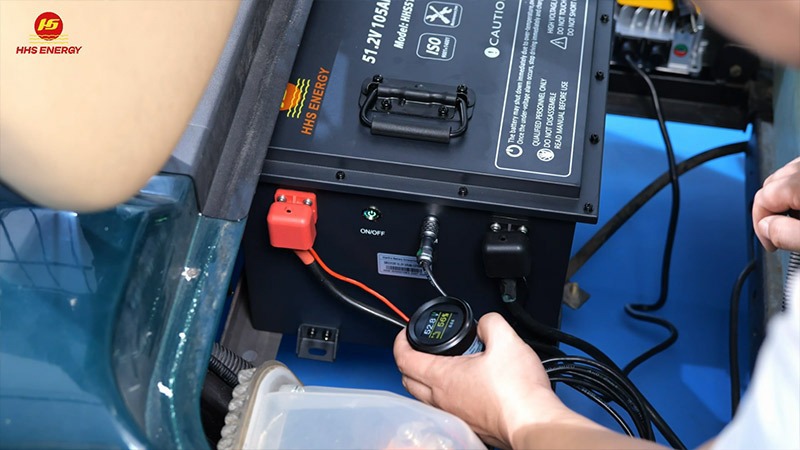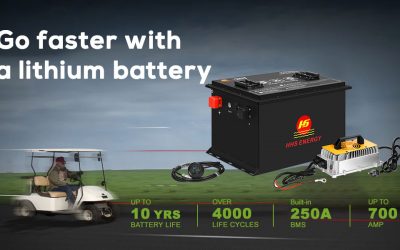How to Convert a Golf Cart to Lithium Batteries ?

🔋 Why Convert to Lithium?
-
Weight Reduction: Lithium packs are ~50–70% lighter than lead-acid, improving speed and handling.
-
Longer Lifespan: LiFePO₄ batteries typically last 8–10 years (3,000–5,000 cycles) vs. 4–6 years for lead-acid.
-
Faster Charging: Can recharge in 2–4 hours with the right charger.
-
Low Maintenance: No watering or acid corrosion.
-
Consistent Power: Voltage stays steady until nearly empty, unlike lead-acid.
⚙️ Step-by-Step Conversion Guide
1. Choose the Right Lithium Battery Pack
Most golf carts run on 36V, 48V, or 72V systems.
-
Example: A 48V cart can be powered by 1 x 48V lithium pack (e.g., 48V 105Ah) instead of 6–8 lead-acid batteries.
-
Look for LiFePO₄ chemistry (safe, long life).
-
Ensure the battery has a built-in BMS (Battery Management System).
👉 Popular options: Bolt Energy, RoyPow, EcoBattery, Allied, Dakota Lithium.
2. Remove Old Lead-Acid Batteries
-
Disconnect negative terminal first, then positive.
-
Remove the hold-down brackets.
-
Lift out each battery carefully (they’re heavy ~60–70 lbs each).
-
Clean and neutralize the battery tray (baking soda + water mix helps remove acid residue).
3. Install the Lithium Pack
-
Place the lithium battery (much smaller and lighter).
-
Use spacers or brackets to secure it.
-
Connect positive (+) and negative (–) terminals.
-
If running multiple lithium batteries in parallel, connect them properly with heavy gauge cables.
4. Upgrade the Charger
-
Standard lead-acid chargers won’t work with lithium.
-
Get a lithium-compatible charger matched to your pack (e.g., 48V LiFePO₄ charger).
-
Some smart chargers even plug into the cart’s existing charge port for convenience.
5. Check Controller & Accessories
-
Most stock golf cart controllers work fine with lithium.
-
But if upgrading to a high-performance lithium pack, you may want a controller upgrade for more torque/speed.
-
Optional: Install a battery meter designed for lithium (since lead-acid meters are inaccurate).
6. Test the Cart
-
Power on the cart, check the voltage with a multimeter.
-
Take a short test drive—listen for loose connections or unusual noises.
-
Confirm smooth acceleration and braking.
💰 Cost of Conversion
-
Battery Pack: $1,800–$3,200 (48V lithium pack, 100–120Ah).
-
Charger: $300–$600.
-
Optional upgrades: Controller, meter, or wiring kit ($200–$500).
👉 Total: $2,200–$3,800 (depending on brand & capacity).
📌 Pros & Cons After Conversion
✅ Pros
-
30–40% lighter golf cart
-
Faster charging
-
2–3x longer lifespan
-
Zero maintenance
-
Better range & consistent performance
⚠️ Cons
-
Higher upfront cost
-
Requires compatible charger
-
Some brands may void warranty if DIY installed (check with manufacturer)
⚡ Range Estimate by Battery Size (48V Carts)
| Battery Size | Typical Range |
|---|---|
| 48V 60Ah | 20–25 miles |
| 48V 100Ah | 35–45 miles |
| 48V 160Ah | 60–75 miles |
🛠️ DIY vs. Professional Install
-
DIY: If you’re comfortable with wiring and safety, you can install in a few hours.
-
Professional: Adds ~$300–$500, but ensures warranty protection and expert setup.
✅ Final Thoughts
Converting your golf cart to lithium is one of the best investments for performance and reliability. While the upfront cost is higher, you’ll save on maintenance, replacement, and charging costs in the long run—and enjoy a smoother, faster ride.





